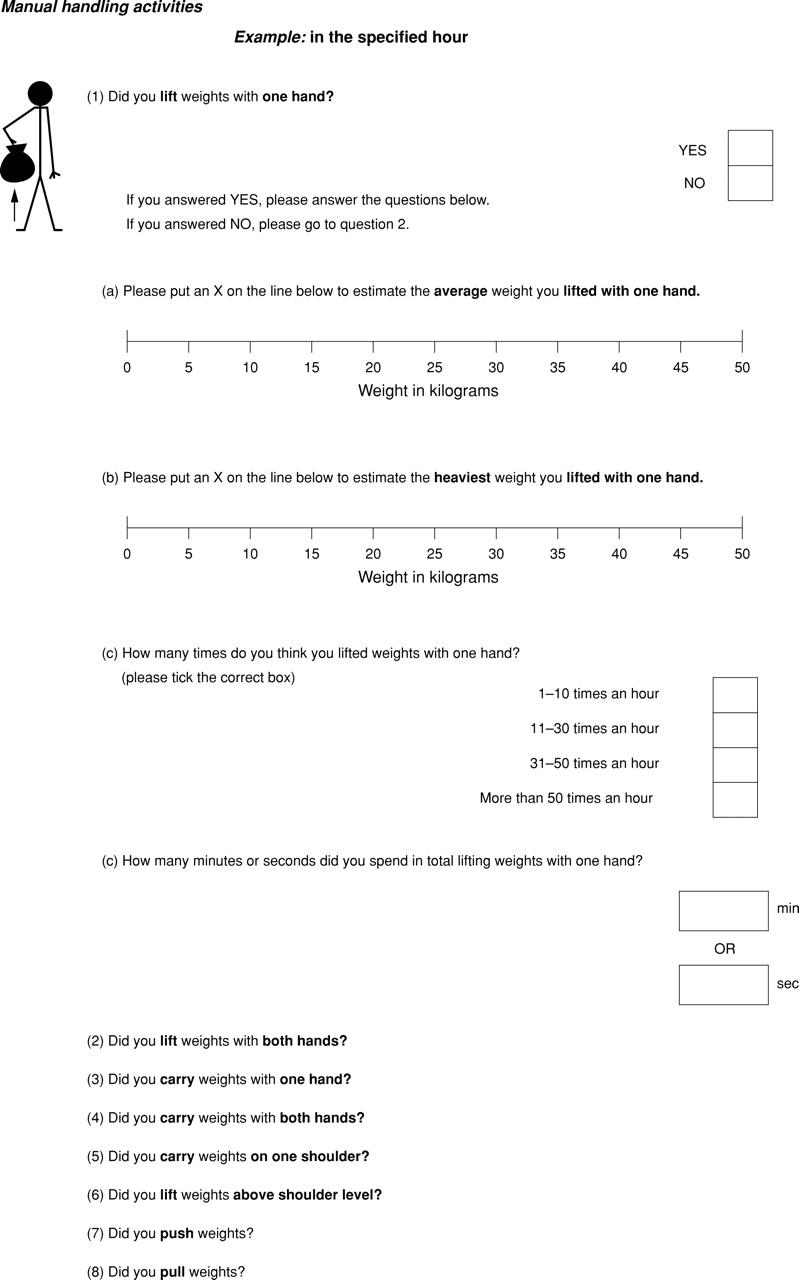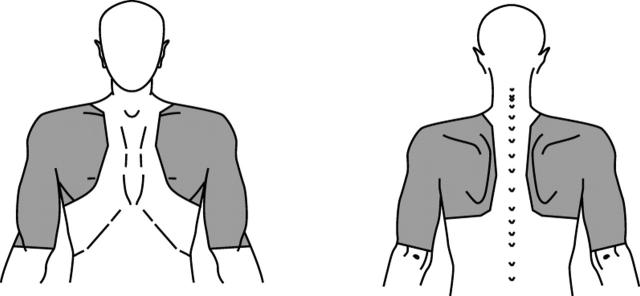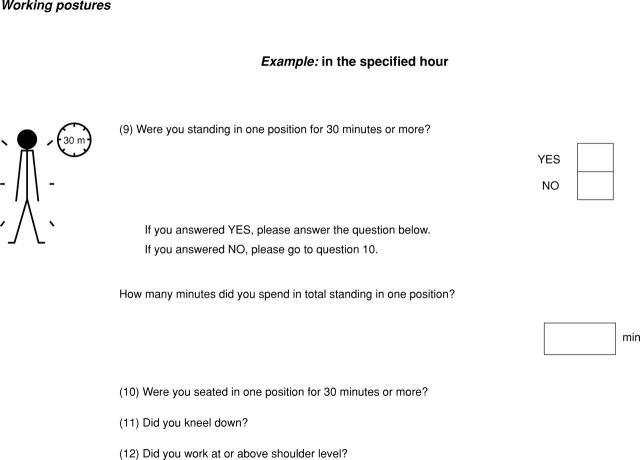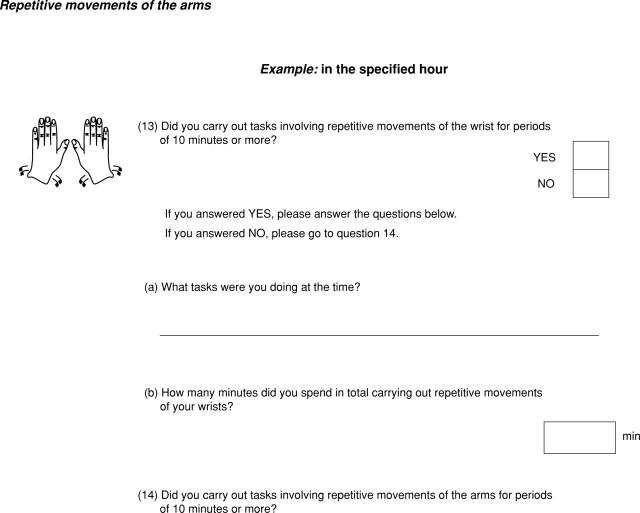Abstract
OBJECTIVE—To estimate the individual and combined associations of physical and psychosocial working environment with disabling shoulder pain and to identify groups at "high risk" for shoulder pain. METHODS—A cross sectional survey was conducted at five manual occupational settings in south Manchester, United Kingdom (n=775, 83%). RESULTS—Both the duration of occupational physical demands (working postures, manual handling activities, and repetitive arm movements) and psychosocial working environment (psychological demands and lack of opportunity to learn new skills) were found to be significantly associated with shoulder pain. Three occupational factors identified a high risk group for shoulder pain: duration of lifting with one hand (prevalence rate ratio (PRR) (highest third) 2.0, 95% confidence interval (CI) 1.4 to 2.8), duration of working above shoulder level (PRR (highest third) 2.2, 95% CI 1.5 to 3.3), and whether employees found their work stressful (PRR (highest third) 1.4, 95% CI 1.0 to 2.1). In addition, a measure of psychological distress (General Health Questionnaire (GHQ) score) was found to identify a group at high risk for shoulder pain (PRR (highest third) 1.9, 95% CI 1.3 to 2.9). In employees exposed to three or more of these factors, 79% (23/29) reported shoulder pain compared with only 16% (56/353) of those not exposed to any. CONCLUSION—This study has identified a variety of occupational physical demands and psychosocial factors associated with shoulder pain. It has also identified groups of employees at a "high risk" for shoulder pain by their exposure to both physical and psychosocial factors.
Full Text
The Full Text of this article is available as a PDF (145.4 KB).
Figure 1 .
Boundary used for the shoulder in defining shoulder pain.

Selected References
These references are in PubMed. This may not be the complete list of references from this article.
- Bergenudd H., Lindgärde F., Nilsson B., Petersson C. J. Shoulder pain in middle age. A study of prevalence and relation to occupational work load and psychosocial factors. Clin Orthop Relat Res. 1988 Jun;(231):234–238. [PubMed] [Google Scholar]
- Bjelle A., Hagberg M., Michaelson G. Occupational and individual factors in acute shoulder-neck disorders among industrial workers. Br J Ind Med. 1981 Nov;38(4):356–363. doi: 10.1136/oem.38.4.356. [DOI] [PMC free article] [PubMed] [Google Scholar]
- Bongers P. M., de Winter C. R., Kompier M. A., Hildebrandt V. H. Psychosocial factors at work and musculoskeletal disease. Scand J Work Environ Health. 1993 Oct;19(5):297–312. doi: 10.5271/sjweh.1470. [DOI] [PubMed] [Google Scholar]
- Buchbinder R., Goel V., Bombardier C., Hogg-Johnson S. Classification systems of soft tissue disorders of the neck and upper limb: do they satisfy methodological guidelines? J Clin Epidemiol. 1996 Feb;49(2):141–149. doi: 10.1016/0895-4356(95)00519-6. [DOI] [PubMed] [Google Scholar]
- Buckle P. Upper limb disorders and work: the importance of physical and psychosocial factors. J Psychosom Res. 1997 Jul;43(1):17–25. doi: 10.1016/s0022-3999(96)00394-7. [DOI] [PubMed] [Google Scholar]
- Croft P., Pope D., Zonca M., O'Neill T., Silman A. Measurement of shoulder related disability: results of a validation study. Ann Rheum Dis. 1994 Aug;53(8):525–528. doi: 10.1136/ard.53.8.525. [DOI] [PMC free article] [PubMed] [Google Scholar]
- Ekberg K., Björkqvist B., Malm P., Bjerre-Kiely B., Karlsson M., Axelson O. Case-control study of risk factors for disease in the neck and shoulder area. Occup Environ Med. 1994 Apr;51(4):262–266. doi: 10.1136/oem.51.4.262. [DOI] [PMC free article] [PubMed] [Google Scholar]
- Ekberg K., Karlsson M., Axelson O., Malm P. Cross-sectional study of risk factors for symptoms in the neck and shoulder area. Ergonomics. 1995 May;38(5):971–980. doi: 10.1080/00140139508925163. [DOI] [PubMed] [Google Scholar]
- Hagberg M., Wegman D. H. Prevalence rates and odds ratios of shoulder-neck diseases in different occupational groups. Br J Ind Med. 1987 Sep;44(9):602–610. doi: 10.1136/oem.44.9.602. [DOI] [PMC free article] [PubMed] [Google Scholar]
- Hales T. R., Bernard B. P. Epidemiology of work-related musculoskeletal disorders. Orthop Clin North Am. 1996 Oct;27(4):679–709. [PubMed] [Google Scholar]
- Holmström E. B., Lindell J., Moritz U. Low back and neck/shoulder pain in construction workers: occupational workload and psychosocial risk factors. Part 2: Relationship to neck and shoulder pain. Spine (Phila Pa 1976) 1992 Jun;17(6):672–677. doi: 10.1097/00007632-199206000-00006. [DOI] [PubMed] [Google Scholar]
- Hotopf M., Mayou R., Wadsworth M., Wessely S. Temporal relationships between physical symptoms and psychiatric disorder. Results from a national birth cohort. Br J Psychiatry. 1998 Sep;173:255–261. doi: 10.1192/bjp.173.3.255. [DOI] [PubMed] [Google Scholar]
- Hughes R. E., Silverstein B. A., Evanoff B. A. Risk factors for work-related musculoskeletal disorders in an aluminum smelter. Am J Ind Med. 1997 Jul;32(1):66–75. doi: 10.1002/(sici)1097-0274(199707)32:1<66::aid-ajim8>3.0.co;2-p. [DOI] [PubMed] [Google Scholar]
- Johansson J. A. Psychosocial work factors, physical work load and associated musculoskeletal symptoms among home care workers. Scand J Psychol. 1995 Jun;36(2):113–129. doi: 10.1111/j.1467-9450.1995.tb00973.x. [DOI] [PubMed] [Google Scholar]
- Lagerström M., Wenemark M., Hagberg M., Hjelm E. W. Occupational and individual factors related to musculoskeletal symptoms in five body regions among Swedish nursing personnel. Int Arch Occup Environ Health. 1995;68(1):27–35. doi: 10.1007/BF01831630. [DOI] [PubMed] [Google Scholar]
- Leino P. I., Hänninen V. Psychosocial factors at work in relation to back and limb disorders. Scand J Work Environ Health. 1995 Apr;21(2):134–142. doi: 10.5271/sjweh.20. [DOI] [PubMed] [Google Scholar]
- Magni G., Moreschi C., Rigatti-Luchini S., Merskey H. Prospective study on the relationship between depressive symptoms and chronic musculoskeletal pain. Pain. 1994 Mar;56(3):289–297. doi: 10.1016/0304-3959(94)90167-8. [DOI] [PubMed] [Google Scholar]
- Ohlsson K., Hansson G. A., Balogh I., Strömberg U., Pålsson B., Nordander C., Rylander L., Skerfving S. Disorders of the neck and upper limbs in women in the fish processing industry. Occup Environ Med. 1994 Dec;51(12):826–832. doi: 10.1136/oem.51.12.826. [DOI] [PMC free article] [PubMed] [Google Scholar]
- Papageorgiou A. C., Macfarlane G. J., Thomas E., Croft P. R., Jayson M. I., Silman A. J. Psychosocial factors in the workplace--do they predict new episodes of low back pain? Evidence from the South Manchester Back Pain Study. Spine (Phila Pa 1976) 1997 May 15;22(10):1137–1142. doi: 10.1097/00007632-199705150-00014. [DOI] [PubMed] [Google Scholar]
- Pope D. P., Croft P. R., Pritchard C. M., Silman A. J. Prevalence of shoulder pain in the community: the influence of case definition. Ann Rheum Dis. 1997 May;56(5):308–312. doi: 10.1136/ard.56.5.308. [DOI] [PMC free article] [PubMed] [Google Scholar]
- Pope D. P., Silman A. J., Cherry N. M., Pritchard C., Macfarlane G. J. Validity of a self-completed questionnaire measuring the physical demands of work. Scand J Work Environ Health. 1998 Oct;24(5):376–385. doi: 10.5271/sjweh.358. [DOI] [PubMed] [Google Scholar]
- Sakakibara H., Miyao M., Kondo T., Yamada S. Overhead work and shoulder-neck pain in orchard farmers harvesting pears and apples. Ergonomics. 1995 Apr;38(4):700–706. doi: 10.1080/00140139508925141. [DOI] [PubMed] [Google Scholar]
- Schibye B., Skov T., Ekner D., Christiansen J. U., Sjøgaard G. Musculoskeletal symptoms among sewing machine operators. Scand J Work Environ Health. 1995 Dec;21(6):427–434. doi: 10.5271/sjweh.58. [DOI] [PubMed] [Google Scholar]





